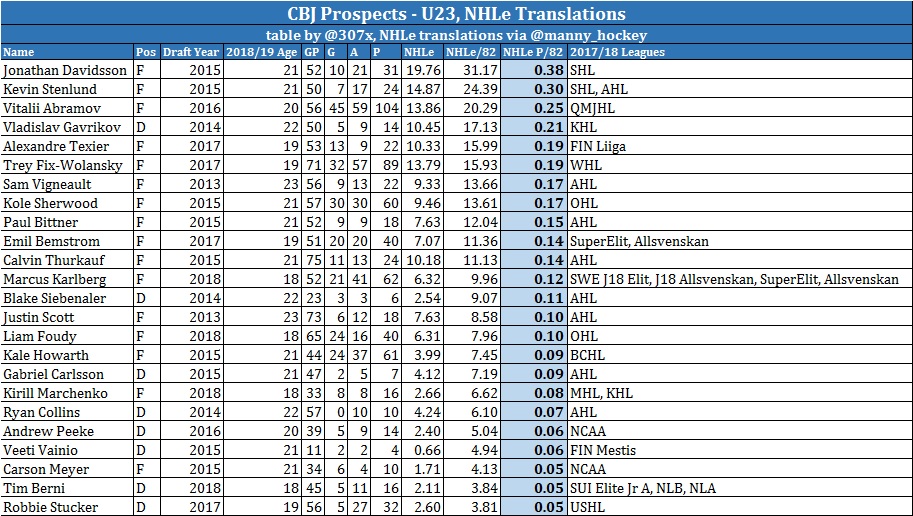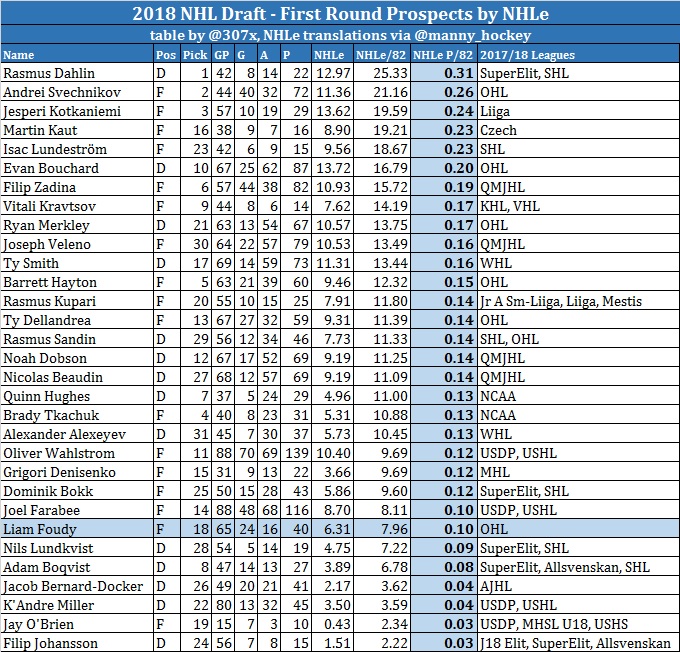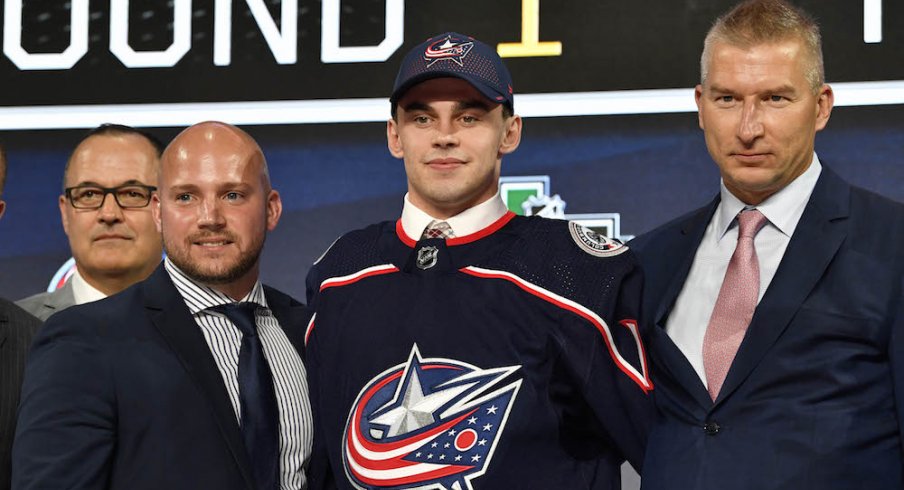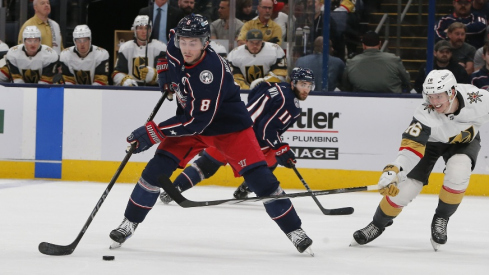How many times have you looked at a team’s prospect, seen obscene point production, and wondered, “how is that guy not in the NHL?” Maybe you look at a super-hyped prospect, a surefire NHL star, and you notice that he only scored 20 points in the Swedish league last year, and you think, “well, that’s not impressive.” Or is it? There is a way to put both performances into a context that accounts for league strength, and makes it easier to compare the two.
NHL equivalencies (or NHLe, which it will be referred to for the remainder of this piece) are, simply, an attempt at translating point totals from non-NHL leagues into what those points would be worth at the NHL level. The purpose is to gauge how effective a player would have been if they were to have played that season in the NHL.
Pioneered by Gabe Desjardins, creator of the original hockey analytics site, behindthenet.ca, NHLe has since been continuously refined and updated by Rob Vollman (@robvollmanNHL), author of hockey analytics books the Hockey Abstract and Stat Shot. A couple of weeks ago, Emmanuel Perry (@manny_hockey), creator and maintainer of renowned hockey analytics site Corsica, took his shot at NHLe ratings, and released his numbers via a thread of tweets.
Ryan Stimson of The Athletic has used this tool to go through the Buffalo Sabres prospects (subscription required). His piece also includes a conversation with Perry about his NHLe factors and how they were modeled. It is worth a read.
These NHLe translation factors are not ironclad, foolproof projections. Mostly, they are for fun. But, they may put production into perspective for some players, or potentially boost the reputation of a lesser prospect without flashy point totals, but who played in a superior league.
We will see examples of both of these in our look at how Columbus Blue Jackets prospects fared in NHLe.
THE NUMBERS

To get NHLe numbers, I input every regular season statline from each under-23 Columbus prospect. Some prospects played in more than one league, so those statlines were all converted individually and then summed up into one tidy number.
One thing that really stands out in looking through the Columbus prospect pipeline is something that’s been mentioned before here at 1st Ohio Battery by Paul Berthelot: there is a notable lack of offensive numbers from Blue Jackets defenders. Vladislav Gavrikov’s 17 NHLe (which is extrapolated from just 14 points in 50 KHL games) is by far the highest, and then it’s a big drop down to Blake Siebenaler (with six points in 23 games). There are no prospects here that have top-four defender potential. It’s not far-fetched to think that both Gavrikov and Gabriel Carlsson can be NHL players, but their more likely role is of a “stay-at-home” type and, in today’s NHL, those are almost exclusively reserved for third pairing roles. More on them later.
Up front, Vitalii Abramov is essentially the Great Hope for the group, the guy that everyone is looking to make the jump and be an impact NHL scorer. Beyond him, Jonathan Davidsson looks great, Kevin Stenlund is intriguing, but neither come off as future major contributors to a successful NHL club. It’s true that the Blue Jackets are likely to be the youngest team in the NHL when the season gets underway, with their top prospects already all graduated.
But, outside of the NHL, there is a lot of forwards who look like depth skaters at best, but almost no star-caliber prospects.
THE BREAKDOWN
While it should be no surprise that the players in the men’s top-tier pro leagues put up the highest NHLe numbers, the names at the top are interesting.
The leader in NHLe points and points per 82 was 2017 sixth-round round pick Jonathan Davidsson. Davidsson played this season with Djurgardens in the Swedish Hockey League, which boasts the second-highest equivalency to the NHL among active leagues, trailing only the KHL. What makes this more impressive is the context; Davidsson was used as a middle-six forward for the powerhouse Djurgardens side, mainly playing on a line with his younger brother, Sabres prospect Marcus, and his childhood friend and Capitals draft pick Axel Jonsson Fjallby. Davidsson averaged just 12:13 of even strength ice time per game but, despite that, put up 29 points (nine goals, 20 assists) in 52 games – good for seventh in the SHL in even strength points. Davidsson’s 2.74 points-per-60 ranked even higher, fifth in the league. Davidsson was an excellent +18 (33 goals for, 15 against), a 68.8% goals for rate, and both of those numbers were top ten in the SHL.
While the chemistry with his line may have been there thanks to bloodlines and familiarity, Davidsson was undoubtedly the play-driver of the trio, putting up points on 87.9% of the goals scored while he was on the ice, well above what his line mates accomplished (75% and 59.1% for Marcus and Jonsson Fjallby respectively). Davidsson has since signed with Columbus and should be fighting for an opening night roster spot. If he does not make the team out of camp, he is most likely to be sent to Cleveland to play big minutes and be a top call-up option. Another scenario is to loan him back to Djurgardens for another season, where he would see an increased role.
A distant second in NHLe is the Jackets’ other SHL prospect, Kevin Stenlund. Playing for HV71, Stenlund’s point production was lackluster (16 even strength points in 43 SHL games, and a 1.66 points-per-60, which put him in middle-six scoring territory), but his icetime usage indicates that he has earned his coaches trust. At even strength, Stenlund averaged nearly 14 minutes per game, ranking in the top 50 among regular SHL forwards in average icetime. He also averaged just under three minutes per game on the power play, and played the occasional penalty kill shift. He was a positive in goals for (GF%), and his role shows that he could be leaned on in all situations. Stenlund also notched two assists in seven games for Cleveland, which were included in his NHLe totals. This season, he will be playing full time with the Monsters, and should see top-six minutes including prime power play opportunities.
Perhaps the biggest surprise is Vitalii Abramov’s NHLe. Abramov spent the season absolutely laying waste to QMJHL goalies, to the tune of 104 points in just 56 games, but his NHLe has that being worth just 20 NHL points. A big reason is that Abramov plays in the highest scoring Canadian major junior league, but also the one with the smallest number of successful NHL graduates. As mentioned previously, though, these numbers are far from ironclad projections. Keep in mind another Blue Jackets QMJHL’er, Pierre-Luc Dubois, is fresh off of a 48-point NHL campaign which followed an underwhelming (to put it nicely) 55-point QMJHL campaign.
Perhaps translating these numbers into AHL totals would be more indicative of Abramov’s potential 2018-19 production.
Using Manny’s numbers, I took Abramov’s 104 points in 56 games, and translated them into the NHLe numbers for the QMJHL (~0.133), then divided by the NHLe number for the AHL (~0.424), and then pro-rated that to 76 games. This gives us an AHLe number of 44.34 points over the course of a 76 game season. If Abramov had put together an AHL season of that caliber, he would have lead the Monsters in points. He should begin the 2018-19 season with Cleveland, so we could soon see this become a reality.
Vladislav Gavrikov has been getting rave reviews from Columbus staff since he was drafted as a double-overager in 2015. It looked as though he was going to make the jump to the Jackets in 2017/18, but instead signed a two-year deal with SKA St. Petersburg in the KHL in order to ensure he would get a chance to play for his country in the 2018 Winter Olympics. Gavrikov is definitely not an offensive defenseman, so his NHLe/82 of 17 points is not a terrible number. What does raise questions is that his 14 KHL points came as a top four defenseman for his club, playing over 20 minutes per night. This low level of production from a top player is a bit worrisome because, generally, players from outside the NHL – even stay-at-home blueliners – put up better-than-average point totals in their non-NHL leagues. Gavrikov is not at that level. If Gavrikov were to join the Blue Jackets in 2019-2020, he would already be in his age-24 season, which is at about the peak of development for most defensemen. Optimistically, Gavrikov’s projection would be similar to that of David Savard’s 2017-18 season: low-to-mid-teens in points, with respectable defensive acumen, capable of playing a competent No. 4-5 role on defense.
Speaking of low-scoring defensemen, Gabriel Carlsson is probably not going to want to dwell on his 2017-18 season any more than he absolutely has to. In his NHLe totals, I actually included the 14 games he played with the Blue Jackets, and his numbers still only hit seven points on the season. Carlsson has never been known for his offensive play, but his defensive work has slipped considerably from what had been promised when the team traded up to draft him in 2015. Carlsson finished a -6 at 5-on-5 with Cleveland, which doesn’t seem too bad considering Cleveland finished with a -48 goal differential at 5-on-5. But that 41.7% goals for number was well below the team average (45.3%) for his time with the club. Let’s remember that one of the picks Columbus gave up to get Carlsson has turned into a player who is already penciled in to be an NHL regular this season: Travis Dermott of the Toronto Maple Leafs.
To prove that Columbus hasn’t made a mistake in making that trade, Carlsson will need to explode in 2017-18 and, hopefully, establish himself as a legitimate NHL option.
2017 second-round pick Alexandre Texier put in a successful rookie season in Liiga, the fourth highest-ranked active league via NHLe. Texier played middle six minutes for KalPa, and also slotted in on the second unit power play. Texier was one of the youngest Liiga regulars and, in fact, was the youngest player drafted in the 2017 NHL Draft. Had Texier been born three days later, he would have been a 2018 first-time eligible. For comparison, Texier is just five months older than Columbus’ 2018 first round pick Liam Foudy, and Texier playing in a vastly superior league. Even with these encouraging numbers, it would be an incredible surprise for Texier to play in the NHL in 2018/19. Instead, he should be returning to KalPa for another season.
Speaking of Foudy, his NHLe score was quite low for a player taken in the first round of the NHL Draft. Among his fellow first rounders, Foudy is near the bottom in NHLe score, and is the second lowest forward (only ahead of Jay O’Brien, a player whose high school league is not included in Manny’s NHLe list). Foudy will be expected to blast through the OHL in his post-draft year, and it should be more exciting to revisit his number next summer.

2018 seventh-round pick Trey Fix-Wolansky notched a similar NHLe to Texier. They are of a similar age (Fix-Wolansky is five months older than Texier), but Wolansky’s 89 points dwarfed Texier’s 22, albeit in an inferior junior league. Fix-Wolansky had the highest NHLe of any player drafted by the Blue Jackets in 2018 (though Fix-Wolansky was a second-year eligible), and only seven players selected in the first round had a higher NHLe. Not bad for a player selected 204th overall. Fix-Wolansky will have one more season of junior hockey in 2018-19 and should be seen as a 20-plus minute a night player for Edmonton in the WHL.
This exercise is meant to be fun. Nothing here is a prediction, but it’s interesting to compare prospects from different leagues, and show just how misleading looking at raw point totals without context can be, or just how close (or far away) from the NHL some of these players may be.
Editor's Note: Jeremy Crowe is a hockey writer and analyst who serves as Coordinator of Hockey Analytics for the OHL's Mississauga Steelheads. Follow Jeremy on Twitter @307x.

